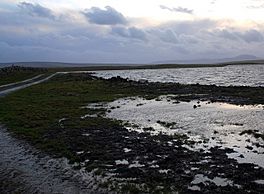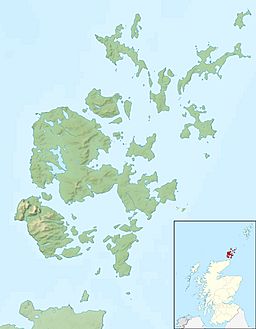Loch of Harray facts for kids
Quick facts for kids Loch of Harray |
|
|---|---|
| Harray lch | |

Looking southwards along the shoreline
|
|
| Location | Mainland Orkney, Scotland |
| Coordinates | 59°1′24″N 3°13′40″W / 59.02333°N 3.22778°W |
| Type | freshwater loch |
| Primary inflows | Burn of Hourston and Burn of Netherbrough |
| Primary outflows | Loch of Stenness |
| Catchment area | 45 sq mi (120 km2) |
| Basin countries | Scotland |
| Max. length | 4.66 mi (7.50 km) |
| Max. width | 1.75 mi (2.82 km) |
| Surface area | 3.75 sq mi (9.7 km2) |
| Average depth | 9 ft (2.7 m) |
| Max. depth | 14 ft (4.3 m) |
| Water volume | 951,000,000 cu ft (26,900,000 m3) |
| Surface elevation | 3.6 ft (1.1 m) |
| Islands | several islets and stones |
The Loch of Harray is the biggest freshwater loch on Mainland Orkney, Scotland. It gets its name from the nearby area of Harray. This loch is special because it's very close to famous ancient sites. These include the Stones of Stenness and the Ring of Brodgar. Both are part of a World Heritage Site. In the old Norse language, its name was Heraðvatn.
Contents
About the Loch's Water
The Loch of Harray is a freshwater loch. This means its water is not salty like the sea. It is the largest loch of its kind in all of Orkney. The loch covers an area of about 3.75 square miles (9.7 square kilometres). It holds a huge amount of water, around 951,000,000 cubic feet (0.0269 km3).
How the Lochs Connect
The Loch of Harray is connected to another loch, the Loch of Stenness. They join at a place called the Bridge of Brodgar. Together, these two lochs are very large. Their combined area is about 19.3 square kilometres (7.5 square miles). This makes them one of the biggest lochs in Scotland. Even though they are connected, the Loch of Harray stays fresh. It doesn't get much influence from the salty tides of the nearby Hoy Sound.
Plants and Animals of the Loch
The Loch of Harray is a very important place for nature. It is a Site of Special Scientific Interest. This means it has special protection because of its unique wildlife.
Unique Plants and Insects
You can find many types of pondweed here. Some of these pondweed species are quite rare. The loch is also home to a special insect. It's a rare caddis fly called Ylodes reuteri. This is the only place in Scotland where this caddis fly is known to live. Another unique creature is a snail called Theodoxus fluviatilis. This type of snail is usually found in rivers in England.
Birds that Visit
Many different kinds of wildfowl come to the loch in winter. These are birds like ducks and geese. Some of the birds you might see include pochard, tufted duck, scaup, and goldeneye. They come to the loch to find food and shelter during the colder months.


